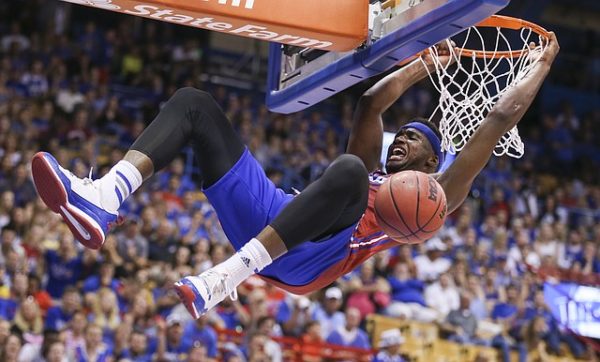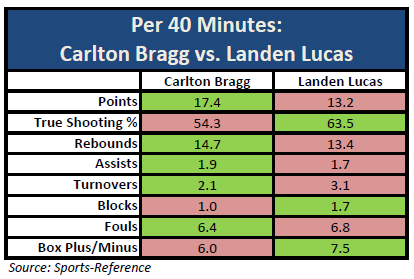Carlton Bragg vs. Landen Lucas: Who Deserves More Minutes?
Posted by Chris Stone on January 3rd, 2017After freshman center Udoka Azubuike suffered a wrist injury that will force him to miss the remainder of the season, the logical replacement in Kansas’ four-guard lineup was senior big man Landen Lucas. Defaulting back to the 6’10” center made good sense as he had been the Jayhawks’ starter during conference play last year and at the beginning of this season. Lucas has also performed admirably in his first two games without Azubuike, averaging a near double-double of 9.5 points and and 14.5 rebounds per game against lowly UNLV and rising conference foe TCU. Those are undoubtedly great numbers, but what if Kansas head coach Bill Self has an even better option sitting on his bench?

Carlton Bragg could help Kansas if he replaces Landen Lucas’ minutes. (Photo Credit: Nick Krug/KUSports)
Sophomore forward Carlton Bragg was expected to step in as a reasonable replacement for departed senior Perry Ellis this season. As a freshman, Bragg had shown an ability to operate from the high post in Self’s offense, capable of knocking down mid-range jumpers with potential to expand his range beyond the three-point arc. It hasn’t exactly turned out that way. With Kansas playing four guards to maximize its backcourt strength, Bragg’s time on the floor has increased but not spiked. He played just 15 and 16 minutes, respectively, in recent games against UNLV and TCU, finding himself behind Lucas in the frontcourt pecking order.
That move is understandable on its face. With four guards surrounding the post, Self needs a big-bodied center who can bang with opponents’ size, clean up the boards and provide a modicum of rim protection. The head coach at this point clearly favors the upperclassman experience of Lucas for that role. The problem is that Bragg has been better than Lucas this season in most relevant metrics. Using their respective statistics per 40 minutes in order to adjust for time spent on the court, here’s a look at how the two big men compare.

The sophomore lags behind the senior in three key categories. The first is true shooting percentage, which is a combination statistic that measures how well a player shoots from both the field and the free throw line. Lucas shoots nearly all of his field goal attempts at the rim (86.0 percent, according to Hoop-Math), meaning he takes plenty of high percentage shots. The next is that Bragg averages 1.0 block per 40 minutes (nowhere near Azubuike, who averaged 5.1 blocks per 40 minutes) but well within the margin of error of Lucas, a solid positional defender but far from a rim protector. The third statistic is Box Plus/Minus, a comprehensive statistic that Lucas leads because of his efficient scoring. In every other relevant category, Bragg has outperformed his senior counterpart on a per-minute basis.

The numbers become even more stark when one or the other is the only big man on the floor. Using Hoop Lens lineup data, Kansas produces 37 points per 100 possessions more than its opponents when Bragg is its lone big man versus just five points better when Lucas is in the center spot. On the offensive side, the Jayhawks are 13 points per 100 possessions better with Bragg as the sole big man despite his lower true shooting percentage. Why? Because everyone else is better. Kansas shoots 56.6 percent on its two-point field goals with the sophomore manning the post: with Lucas, that number drops to 51.3 percent, per Hoop Lens. Bragg’s ability to knock down mid-range jumpers in pick-and-pop action opens the lane for the Jayhawks guards to find space, whereas Lucas either has to roll to the basket or set up on the low blocks. His limitations may serve to remove some high percentage shot opportunities from Kansas’ best scorers like Frank Mason and Josh Jackson. On the defensive side, a difference of 19 points per 100 possessions is a very significant finding, and opponents’ three-point shooting sticks out as a probable difference-maker. Kansas’ opponents connect on just 30.3 percent of their attempts with Bragg in the post, but that number rises to 36.6 percent with Lucas inside. One possible explanation for this difference is that Lucas is a tick slower in recovering on pick-and-roll defense, meaning that the Jayhawks must help on Lucas’ man a half-second longer — ultimately resulting in open perimeter shooters.
Without a more in-depth review of game film, these possible explanations for the differences in Bragg and Lucas’ production at the center position are only theories supported with logic. In either instance, though, the numbers on both ends of the floor show that Kansas has been a better team over the available sample with Bragg as its lone big man. As conference play continues, keep an eye on whether the sophomore earns more minutes in Self’s rotation at the center spot. With the margin for error in this league appearing minimal at the top, it could make all the difference for the Jayhawks down the stretch.









































